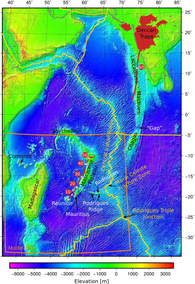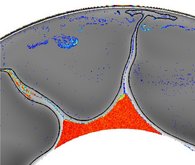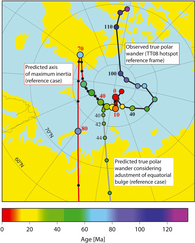The Earth's mantle behaves like a very viscous liquid over extended geological periods. Cold earth plates sink from the surface to the core-mantle boundary, and hot material rises from there in the form of mantle plumes and as large-scale upwellings. By numerical modeling with different observation data, in particular from seismology, geodesy and mineral physics as boundary conditions, we try to better understand processes in the Earth's interior. In particular, we investigate the following topics:
Relationship between mantle convection and lithosphere dynamics on Earth, Moon and planets
Mantle convection provides the driving forces for tectonic plate motions on Earth. It causes lithospheric stresses and vertical deflection, so-called dynamic topography, on the Earth and other celestial bodies. We model these processes numerically. By striving for the best possible match between model results and observation data, we try to obtain knowledge about density distribution and rheology. We are also interested in how dynamic topography may influence surface processes, such as glaciations.

Hotspot tracks and other reference frames for plate tectonics
To understand the interaction of the Earth surface and the deep mantle through geologic time, it is necessary to know the tectonic plate motions over the mantle. The geometry and age progression of hotspot tracks are an important constraint for such plate motions. We contribute to improving hotspot reference frames, taking new radiometric age dates, and numerical models of hotspot motion into account.
Role of mantle plumes in the dynamics of the Earth mantle
As subducted slabs sink to the lowermost mantle, they push ahead both the hot thermal boundary layer above the core-mantle boundary and chemically heavy material that accumulates in the lowermost mantle. The heavy material is piled up, and the hot material rises as plumes from the pile margins. We investigate how and where plumes and piles form, and how the entrainment of heavy materials influences the dynamics of plumes.
Interaction of mantle plumes and lithosphere
When plumes impinge the base of the lithosphere, they may cause intraplaplate volcanism. However, the distribution of volcanism critically depends on lithosphere thickness variations, and whether spreading ridges are closeby. We perform numerical models of plumes interacting with imposed surface plate motions and lithosphere of variable thickness. Modelled plume shape is compared with tomographic images; modelled distribution of melts is compared with hotspot tracks. We have done case studies for Tristan, Reunion, Iceland and Kerguelen. We also study how mantle plumes may affect plate motions.
True pole wander
A re-orientation of the solid Earth as a whole relative to the spin axis is called true polar wander. It is caused by changes in the mass distribution of the Earth. We model true polar wander, for example due to the changing distribution of subduction through Earth history. Modelling results are compared with observation-based polar wander, which is inferred from differences of plate motions in the paleomagnetic frame, and in the reference frame of the Earth mantle. Discrepancies can for example be due to deficiencies in the subduction history model.








